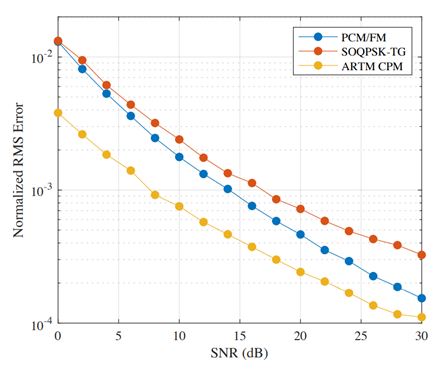
Aeronautical Telemetry
Aeronautical telemetry is the process of transmitting measurements wirelessly from an airborne test article to a ground-based receiver. It is a critical service for flight test missions, in which a ground station monitors the data collected from the aircraft in real time to assess the performance and safety of the flight. Thus, the reliability and efficiency of the RF link is highly important. Aeronautical telemetry is generally implemented with continuous phase modulations (CPM) because they are constant envelope and spectrally efficient. As spectrum reallocations have reduced the spectrum available for aeronautical telemetry, spectrally efficient alternatives have been adopted in the aeronautical telemetry standard IRIG 106. On any given day, there may be flight tests using one of three different modulations. An interesting problem is automatic modulation recognition – the ability to determine the modulation without any information besides the signal itself. While there are good techniques for automatic modulation recognition for linear single carrier modulations, this problem is notoriously hard for CPM.
Continuous Phase Modulation (CPM)
CPM is a class of nonlinear modulations in which the data to be transmitted is encoded in the instantaneous phase. The relatively compact power spectral density of CPM makes it appealing given the reduced spectral allocations available to aeronautical telemetry. Three commonly used types of CPM are PCM/FM, SOQPSK-TG, and ARTM CPM.
PCM/FM has been used since the 1970s and is a partial response CPM with a binary alphabet, modulation index h = 0.7, and a frequency pulse spanning three bit times.
SOQPSK-TG is a partial response CPM with a constrained ternary alphabet, modulation index h = 0.5, and a frequency pulse spanning eight bit times.
ARTM CPM is a partial response CPM with quaternary alphabet, two modulations indexes h = {4/16, 5/16} applied in an alternating fashion, and a pulse shape spanning three symbol times.
The graph below plots the PSD of each of the modulation types. As can be seen, PCM/FM has a shape quite distinct from that of SOQPSK-TG and ARTM CPM. ARTM CPM has the narrowest frequency range of the three types.

Machine Learning for Modulation Recognition and Bit Rate Estimation
Machine learning algorithms are highly effective for finding patterns in data and predicting responses to new input. Many statistical machine learning algorithms are supervised learning methods comprising two steps: training on input data with known target values, and then using the trained model to make predictions on new data. Algorithms can perform both classification on categories and regression on a continuous set of values. Many of the common machine learning classifiers have been applied to the problem of automatic modulation recognition.
We trained machine learning algorithms on the center points of the power spectral density (PSD) estimate of each signal both to classify the type of CPM and to estimate the bit rate at which it was transmitted. Of the models we tested, the quadratic discriminant performs best at classifying the modulation and the Gaussian process regression model performs best at estimating the bit rate. The graphs below show the percent of correct classifications and the error of the bit rate estimation, plotted against signal to noise ratio in both cases. As can be seen, classification has 100% accuracy until SNR drops below 5 dB. Bit rate estimation error steadily increases as the SNR decreases.


What Now?
The accuracy of machine learning in classifying the modulations and estimating the bit rate is good but could be better for lower SNRs. We are investigating ways to improve our trained models, such as estimating the bit rate first in order to choose a sampling rate which could help with classification or using something other than the PSD to use as predictors. Alternatives to PSD could include spectral correlation density (similar to PSD but only applicable to cyclostationary processes) or a method proposed by Philippe Loubaton et al. based on modulation index and cyclic properties of CPM.